Wall painting
Only the nave of the church built in the 13th–14th centuries survived a massive reconstruction in the 15th–16th centuries. The mural paintings with dates in the nave were created between these two construction periods, in 1419.
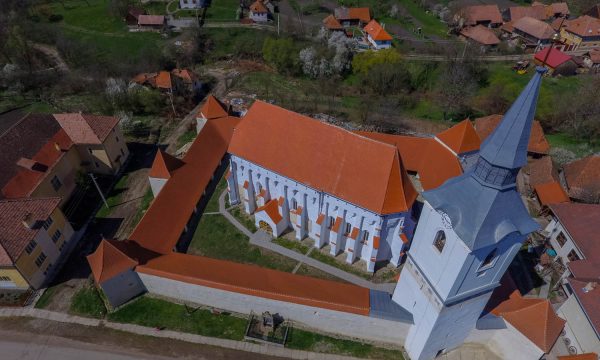
The church shows features of the defensive architecture of the Transylvanian Saxons, with its heightened walls with loopholes and machicolations and four corner towers, and was probably fortified at the turn of the 16th–17th centuries. Its current roof structure was built after the raids led by Basta in 1606. The Renaissance-style tombstones of Benedek Cseffei from 1578 and of Mihály Petky from 1582 can be found here. An inscription on the northern wall of its nave commemorates the renovation of the church in 1640. In 1726 a new gallery was built on the western side, and in 1760 the shingle roofing of the church was replaced with tile. Its southern and western porticos were probably built in 1781. The stucco decorations on its triumphal arch can be dated to the end of the 18th century. The majority of its blue painted furniture were created at the end of the 18th century as well.
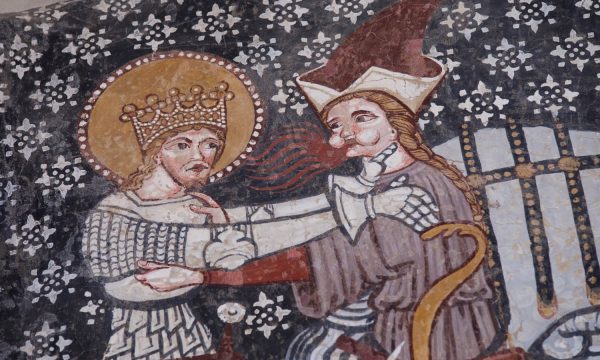
Its murals were brought to light during a major interior restoration in 1887. These were also discovered by József Huszka. The earliest paintings from the murals painted in several periods have been preserved on the northern wall of the nave, under the legend of St. Ladislaus. The most recent ones were revealed in the choir by József Huszka. However, these al secco fragments that could not be easily identified were later covered with plaster again. Such fragments of frames were discovered on the outer southern wall of its nave, too, which could point to the existence of a large-scale figurative representation. On a large, continuous surface on the southern wall well-preserved paintings from 1419 can be seen, depicting bishop saints, St. Michael, and the Conversion of St. Paul. This masterpiece is one of the most significant works of our late medieval mural paintings, from which the legend of St. Ladislaus can be seen on the northern wall. Though the painting was damaged during the construction of the late Gothic net-vaulting, the damage was not that significant, as all its scenes can still be identified today. The scene of the army riding out of the castle, above the gallery, was not discovered during the research led by Huszka, it was found by the restorers led by Péter Pál approx. 10 years ago. Their aesthetic restoration was completed in the late autumn of 2016, so this impressive work of art can be studied in all its original splendour today. Almost all of the “classic” scenes can be found in the cycle. It starts with a special scene of the army riding out of the castle, the largest compositional element is the chase, followed by the fight, the killing of the Cuman and the king resting.
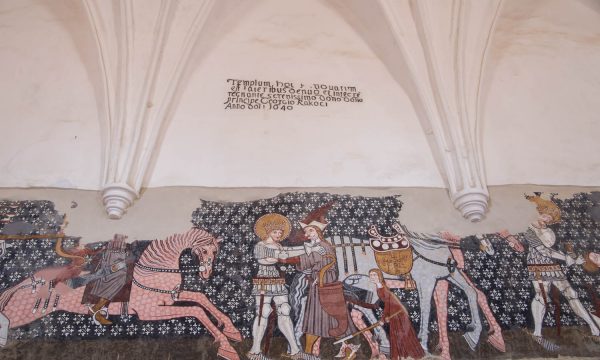
Based on the specific painting techniques used, characteristic figures, horse illustrations, the ornamental elements regularly used in the background etc. it is clear that this cycle was painted by the same artist or workshop that worked in Armășeni (Hu: Csíkmenaság) and in Sânmartin (Hu: Csíkszentmárton). The figures of three standing saints have been preserved after the legend, in a separate frame, close to the triumphal arch. However, only Saint Anthony can be identified from them.
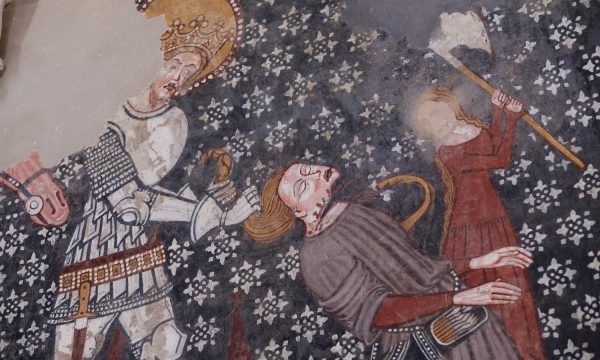
In this same place, but at the other end of the sequence of images, a small fragment of the death of the 10,000 martyrs has been preserved, which was previously mistakenly identified as Jesus laid in the tomb. We know of a similar representation in the church in Feliceni (Hu: Felsőboldogfalva), the murals of which share many common features with the works painted by the workshop that also worked in Dârjiu. Beside the paintings preserved at their original locations, two smaller fragments depicting faces have been transported to Budapest, to the Hungarian National Gallery.
Legend
The most artistic cycle of murals depicting the Saint Ladislaus legend can be seen in the Unitarian church of Dârjiu, in the historical seat of Odorhei (Hu: Udvarhelyszék). The fresco painted in 1419 is also valuable ethnographically, as it contains a number of scenes / motifs that can only be understood with reference to the folklore analogies. The story, which is embodied in a series of paintings depicting Saint Ladislaus’ Chiraleș (Hu: Kerlés) adventure, is a traditional complex consisting of three epic levels. It is defined by a mythical layer depicting the fight of light and darkness. It also contains an archaic heroic level in which most of the pre-conquest motifs and pre-Christian memories have survived. Finally, the latest layer of this artwork depicts the story of the hero protecting the country.
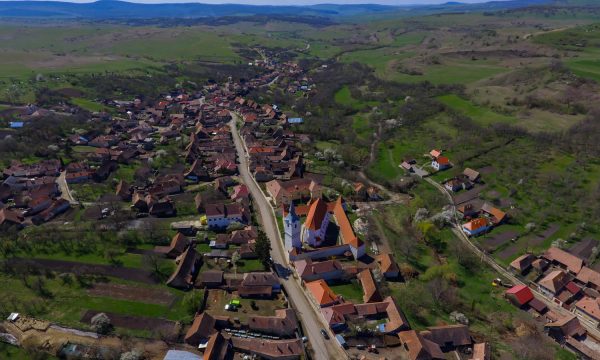
The artistic power of the Saint Ladislaus legend in Dârjiu is made more authentic by the realistic representation. Gyula László showed, for example, that the representation of the Cuman’s quiver was such a precise depiction that only a master very familiar with 15th century material culture (weaponry) could have been capable of. The painter of Dârjiu has added several of the folkloristic motifs of the mural cycle to the scene: the mythical enemy can only be wounded at a single point, his tendon, and his demonic nature is indicated by the motifs of the smoke and the breathing of fire. Finally the resting scene at the end of the cycle includes, as do some of our old-style folk ballads, a love motif from the heroic songs of the pre-conquest period, that of the “head searching”, as well as that of the song-ending heroic dream.
Dârjiu belongs to the few Szekler settlements where the story of the saving of the girl on the wall painting was taken up by the local oral tradition, as several text versions were recorded – that is, only after the frescoes were revealed at the end of the 19th century. However, folklore traditions associated with St. Ladislaus have survived even after the people of the village had become Unitarians, as suggested by the name of the Saint Ladislaus hill (Hu: Lászlóhegye) close to Dârjiu, as well as the ballad fragment claiming that this elevation was named after St. Ladislaus, who came from there into the village when visiting the area.
Three beautiful fairies fell in love near the village of Dârjiu. After the oldest, a well was named: the well of Clara. The middle one gave her name to the nearby village, Daia (Hu: Székelydálya). The youngest was called Ramocsa, because wherever her feet fell, a flower – called ‘ramocsavirág’ by the locals – blossomed. This legend holds the key to Dârjiu’s most important natural treasure. The Ramocsa Hill is located on the outskirts of the village and it is a particularly important habitat for the native rose daphne (daphne cneorum), which is a prostrate spreading evergreen shrub with shiny oval dark green leaves. Its cyclamen-pink flower, made up of sepals, and with its petals regressed, blooms in the middle of April and resembles the lilac both in appearance and scent.
According to the legend, before the three fairy maidens fell in love, they traveled all over Transylvania. Maybe we owe them for our picturesque landscapes! The meadows and pastures spotted with trees and pools, which have become rare elsewhere in Europe, praise the handiwork of the local farmers. Thanks to the small-scale and mosaic-like patterns of local agriculture, various wildflower meadows have evolved with diverse plant species. The wooded pastures, used from the 12th century onward, are appreciated by the locals for their beauty as well as for their various roles. These trees, growing in no particular pattern, provide shade and nutrition for the grazing animals and the people as well. The oldest, rotting trees are home to numerous insects, while the ponds and puddles are maintained by the sheep and buffaloes, and several protected frog and newt species live in them. Such rich wooded pastures with this many diverse species can no longer be found elsewhere in Europe. It is well then that these fabled landscapes are protected by the Sighișoara-Târnava Mare 2000 nature protection area which starts only a few kilometres west from Dârjiu.
